Lung Cancer Staging
After determining a diagnosis of small cell or non-small cell lung cancer there may be additional testing to determine if the cancer cells have spread within the chest or to other parts of the body. Information gathered determines the stage of the disease and the treatment plan. After your oncology team has completed the diagnostic tests, they will meet with you to discuss treatment options.
Small Cell Lung Cancer Staging
Small cell lung cancer staging falls under one of two categories: limited and extensive.
In limited-stage small cell lung cancer, cancer is found in one lung, the tissues between the lungs, and nearby lymph nodes only. Alternatively, extensive-stage small cell lung cancer has spread outside of the lung in which it began or to other parts of the body.
There is another, more formal system to describe the stage of lung cancer, but SCLC is almost always staged as a limited or extensive stage as described above.
Non-Small Cell Lung Cancer Staging
The stages of NSCLC can be complex. Your oncologist will meet with you to review the results of the tests and discuss your next steps for lung cancer treatment based on the stage.
The TNM System for lung cancer staging
- T - Tumor: How large is the tumor? Has it grown into nearby structures or organs?
- N - Nodes: Has there been spread to nearby lymph nodes?
- M - Metastasis: Has the cancer spread to organs outside of the primary cancer site such as the bones, adrenal glands, liver, or the other lung?
Additional tests and procedures may be used during the non-small cell lung cancer staging process. These include:
- Lymph node biopsy
- Mediastinoscopy: A surgical procedure to look at the organs, tissues, and lymph nodes between the lungs for abnormal areas. An incision (cut) is made at the top of the breastbone, and a mediastinoscope is inserted into the chest. A mediastinoscope is a thin, tube-like instrument with a light and a lens for viewing. It may also have a tool to remove tissue or lymph node samples, which are checked under a microscope for signs of cancer.
- Anterior mediastinotomy: A surgical procedure to look at the organs and tissues between the lungs and between the breastbone and heart for abnormal areas. This is also called the Chamberlain procedure.
Stages of Non-Small Cell Lung Cancer
Occult (hidden) cancer
The main tumor can’t be assessed for some reason, or cancer cells are seen in a sample of sputum or other lung fluids, but the cancer isn’t found with other tests, so its location can’t be determined. The cancer is not thought to have spread to nearby lymph nodes or to distant parts of the body.
Stage 0 Lung Cancer
The tumor is found only in the top layers of cells lining the air passages, but it has not invaded deeper into other lung tissues. The cancer has not spread to nearby lymph nodes or to distant parts of the body.
Stage I Lung Cancer
A small tumor that has not spread to any lymph nodes. It is possible for a surgeon to completely remove it. Based on the size of the tumor, Stage I is divided into 2 stages:
- Stage IA: The tumor is 3 centimeters across or smaller. It has not reached the membranes that surround the lungs, and it does not affect the main branches of the bronchi. Cancer has not spread to nearby lymph nodes or to distant parts of the body.
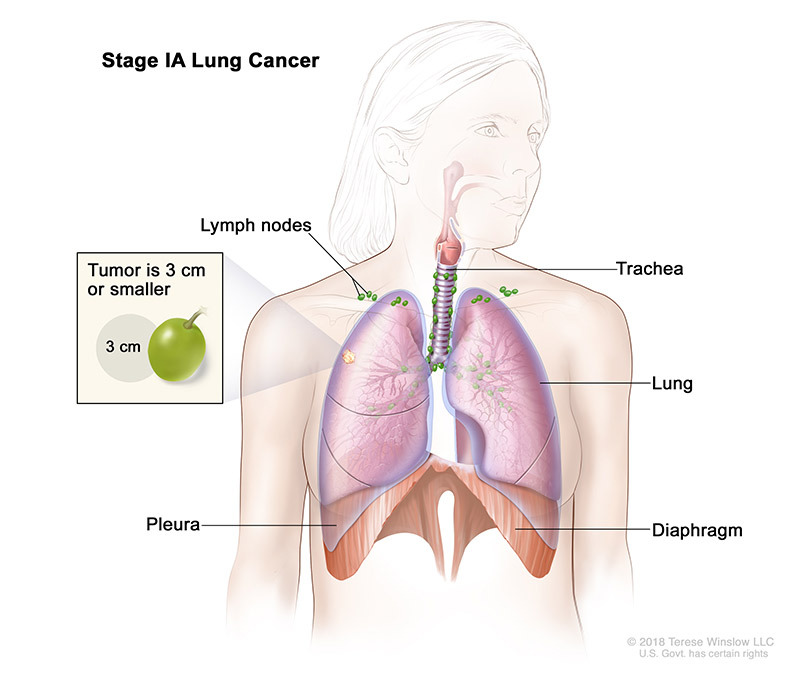
- Stage IB: The cancer has not spread to nearby lymph nodes or to distant parts of the body. The tumor has one or more of the following features:
- It is larger than 3 centimeters but not larger than 4 centimeters across.
- It has grown into the main bronchus but is not within 2 centimeters of the carina.
- It has grown into the membranes surrounding the lungs.
- It is partially clogging the airways.
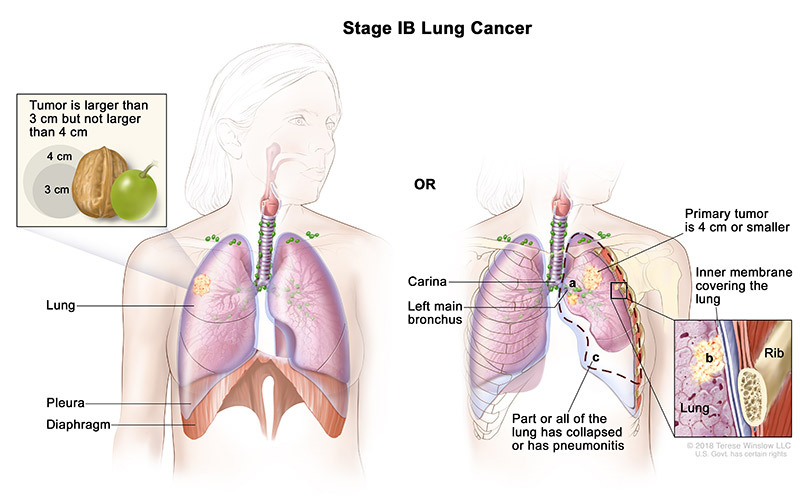
Stage II Lung Cancer
Stage II is divided into stages IIA and IIB:
- Stage IIA: The tumor is larger than 4 centimeters, but not larger than 5 centimeters and has not spread to nearby lymph nodes or to distant parts of the body. The tumor has one or more of the following features:
- It has grown into the main bronchus but is not to the carina.
- The tumor has grown into the membranes surrounding the lungs.
- The tumor is partially clogging the airways.
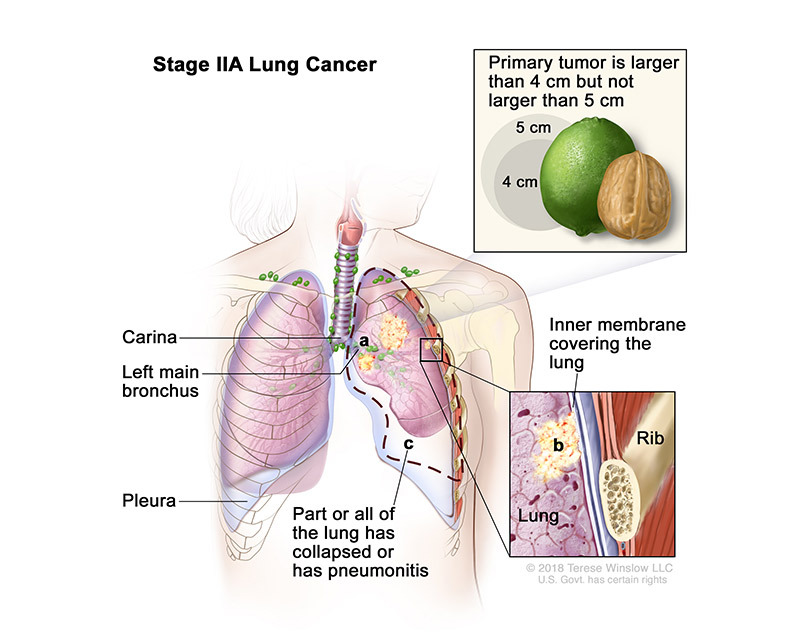
- Stage IIB (1): The tumor is larger than 3 centimeters but not larger than 5 centimeters across. Cancer has also spread to lymph nodes on the same side of the chest as the primary tumor. The lymph nodes with cancer are within the lung and/or around the area where the bronchus enters the lung. The tumor has one or more of the following features:
- It has grown into the main bronchus but is not in the carina.
- It has grown into the membranes surrounding the lungs.
- It is partially clogging the airways.
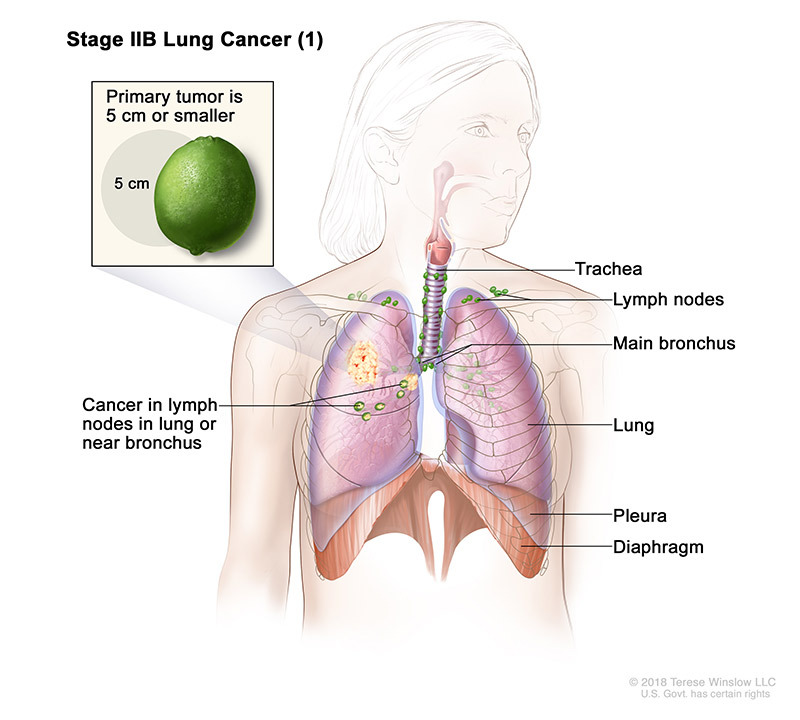
OR
- Stage IIB (2): The tumor is larger than 5 centimeters but not larger than 7 centimeters across. The cancer has not spread to nearby lymph nodes or distant parts of the body. The tumor has one or more of the following features:
- It has grown into the chest wall, the inner lining of the chest wall, the phrenic nerve that controls the diaphragm, or membranes of the sac surrounding the heart.
- There are 2 or more separate tumor nodules in the same lobe of a lung.
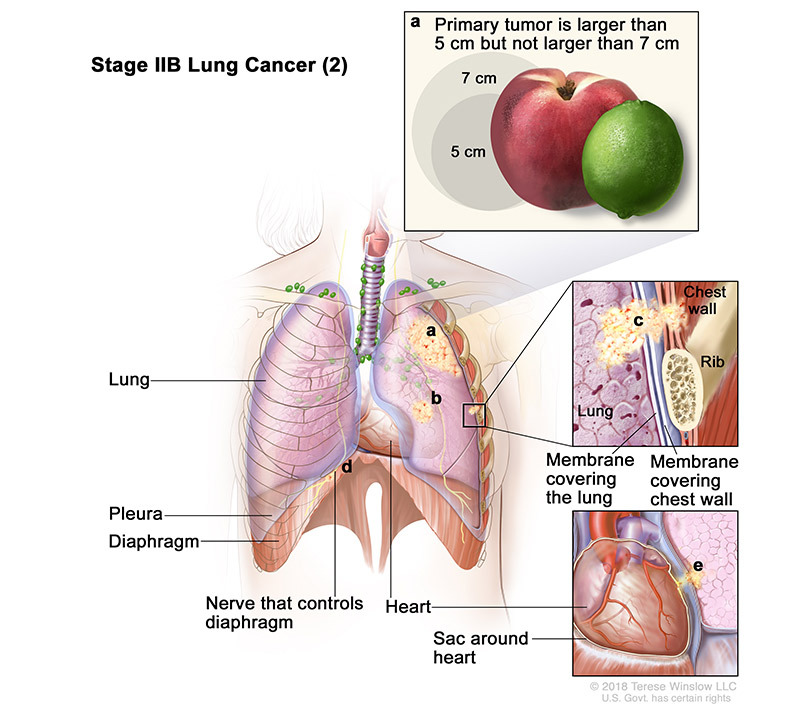
Stage III Lung Cancer
The lung cancers are categorized as either stage IIIA, IIIB, or IIIC. The stage is dependent on the size of the tumor and which lymph nodes cancer has spread to. Stage III cancers have not spread to other distant parts of the body.
- Stage IIIA (1): The cancer has spread to the lymph nodes on the same side of the chest as the main lung tumor. The tumor has one or more of the following features:
- The tumor is 5 centimeters or smaller.
- It has grown into the main bronchus but is not in the carina.
- It has grown into the innermost layer of the membrane that covers the lung.
- It is partially clogging the airways.
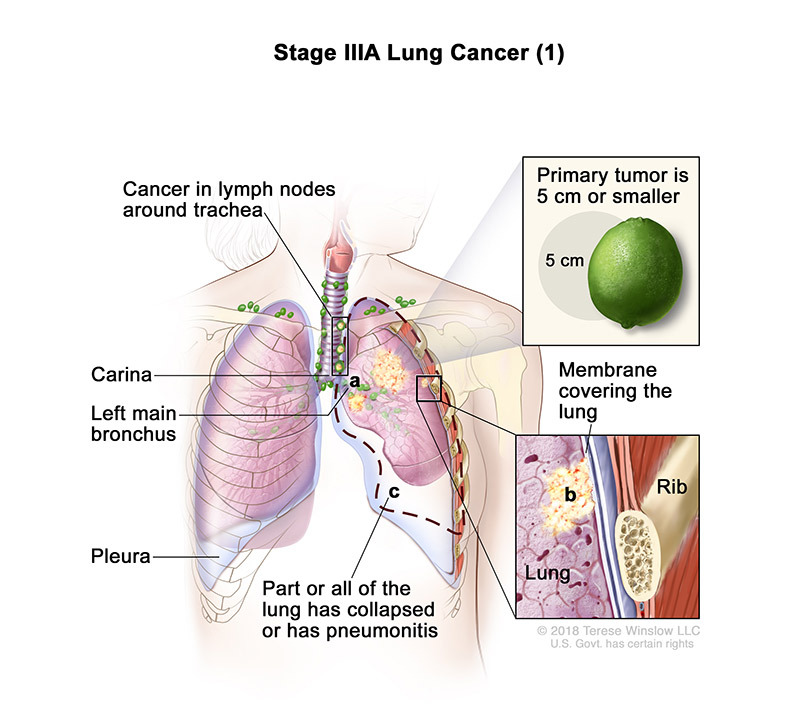
OR
- Stage IIIA (2): The cancer has also spread to lymph nodes within the lung and/or around the area where the bronchus enters the lung. These lymph nodes are on the same side as the cancer. The tumor has one or more of the following features:
- It is larger than 5 centimeters but not larger than 7 centimeters across.
- It has grown into the chest wall, the inner lining of the chest wall, the phrenic nerve, or membranes of the sac surrounding the heart.
- There are 2 or more separate tumor nodules in the same lobe of a lung.
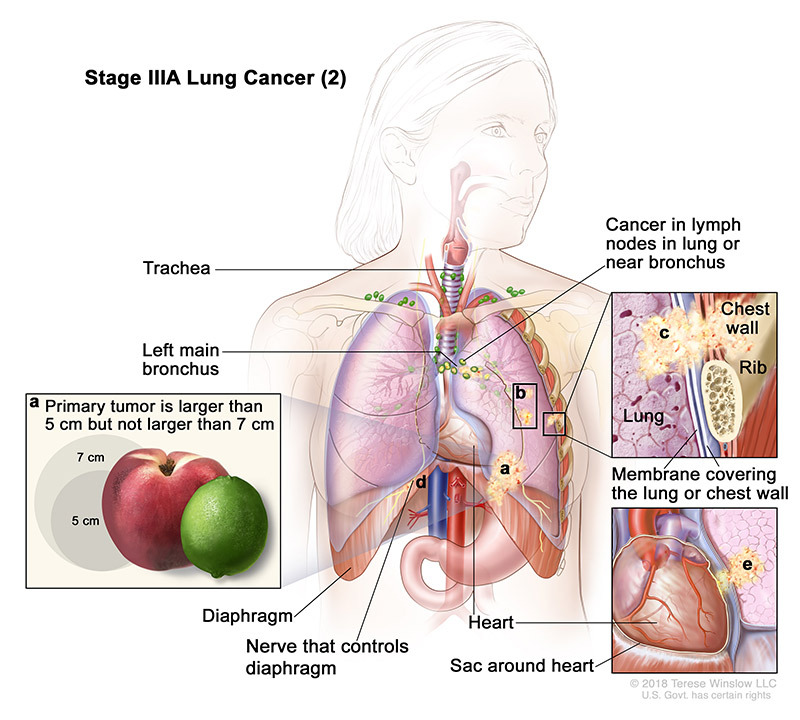
OR
- Stage IIIA (3): The cancer may or may not have spread to lymph nodes within the lung and/or around the area where the bronchus enters the lung. Any affected lymph nodes are on the same side of the chest as the primary cancer. The tumor has one or more of the following features:
- It is larger than 7 centimeters across.
- It has grown into the space between the lungs, heart, large blood vessels near the heart, trachea, esophagus, voice box, diaphragm, backbone or breastbone, or the carina.
- There are 2 or more separate tumor nodules in different lobes of the same lung.
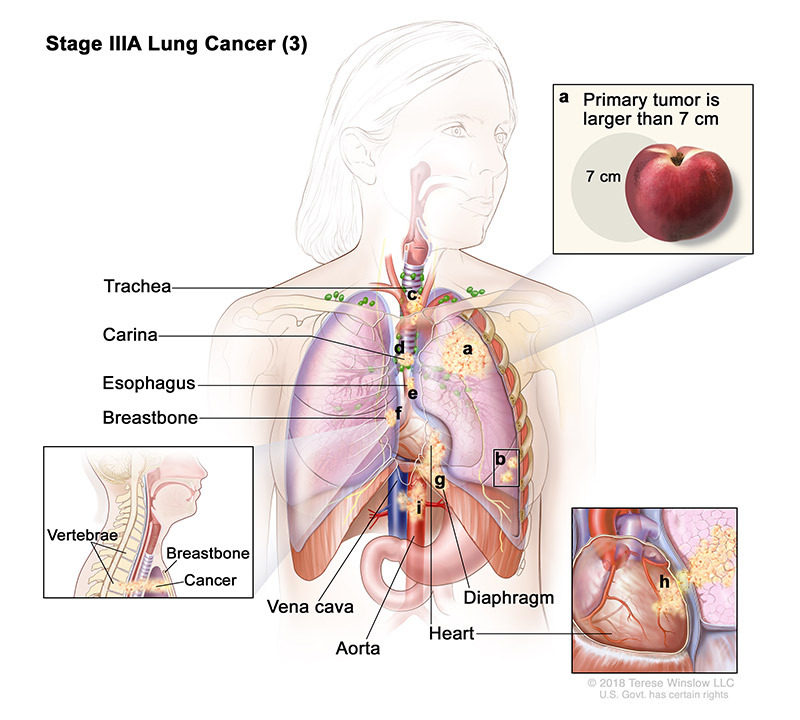
- Stage IIIB (1): The cancer has spread to lymph nodes near the collarbone, and/or has spread to lymph nodes on the other side of the body from the primary tumor. The tumor has one or more of the following features:
- It is larger than 3 centimeters but not larger than 5 centimeters across.
- It has grown into the main bronchus but is not within the carina.
- It has grown into the innermost layer of membrane that surrounds the lungs.
- It is partially clogging the airways.
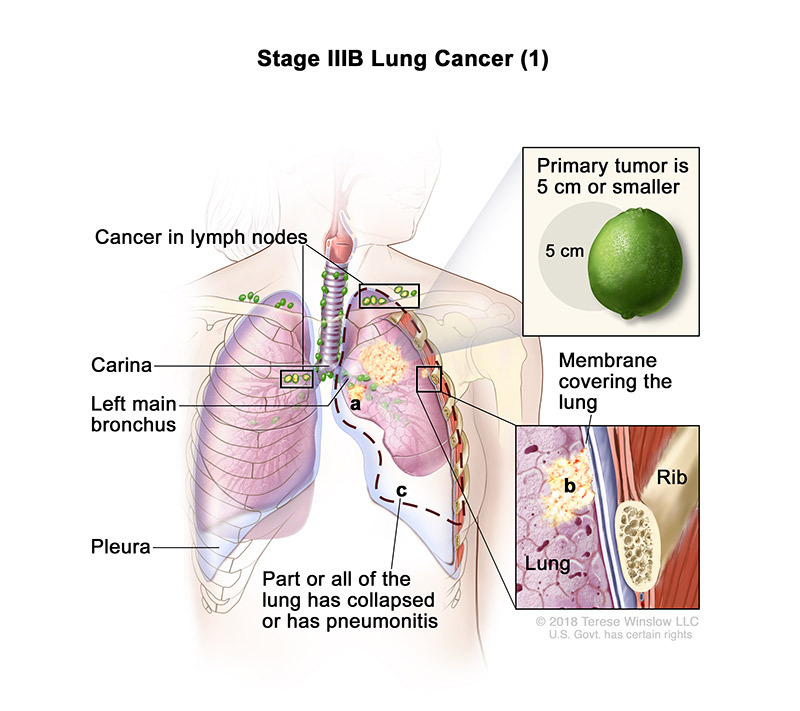
OR
- Stage IIIB (2): The cancer has spread to lymph nodes around the carina or in the space between the lungs. These lymph nodes are on the same side as the main lung tumor. The tumor has one or more of the following features:
- There are 2 or more separate tumor nodules in the same lobe of a lung.
- It has grown into the space between the lungs, heart, large blood vessels near the heart, trachea, esophagus, the voice box, diaphragm, backbone, breastbone, or the carina.
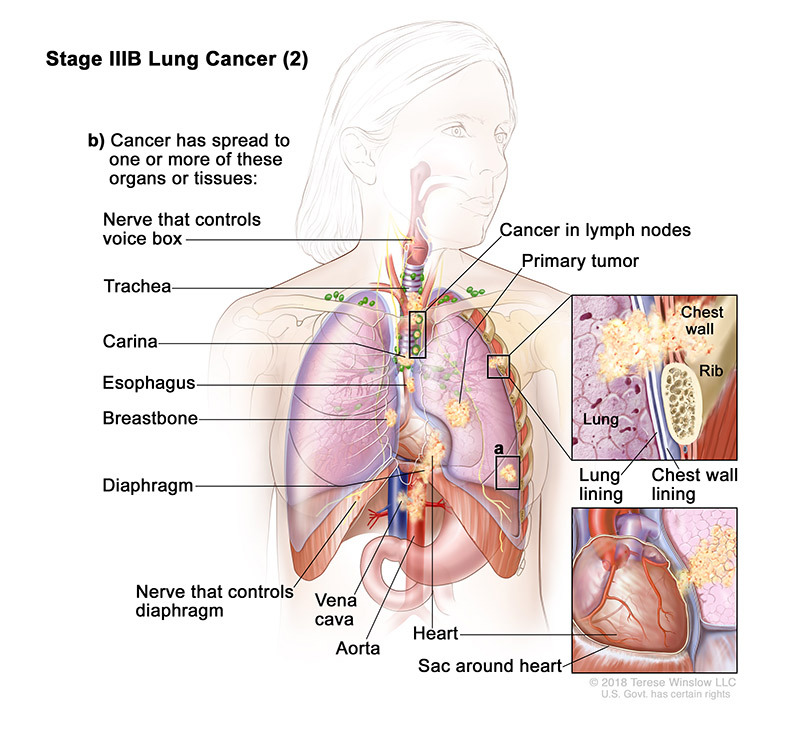
Stage IIIC Lung Cancer
The cancer has spread to lymph nodes near the collarbone, and/or has spread to lymph nodes on the other side of the body from the main tumor. The tumor has one or more of the following features:
- There are two or more separate tumors in the same lobe or a different lobe of the lung with the primary tumor.
- It has grown into the chest wall, the inner lining of the chest wall, the phrenic nerve, membrane surrounding the heart, large blood vessels near the heart, trachea, esophagus, diaphragm, the breastbone or backbone, or the carina.
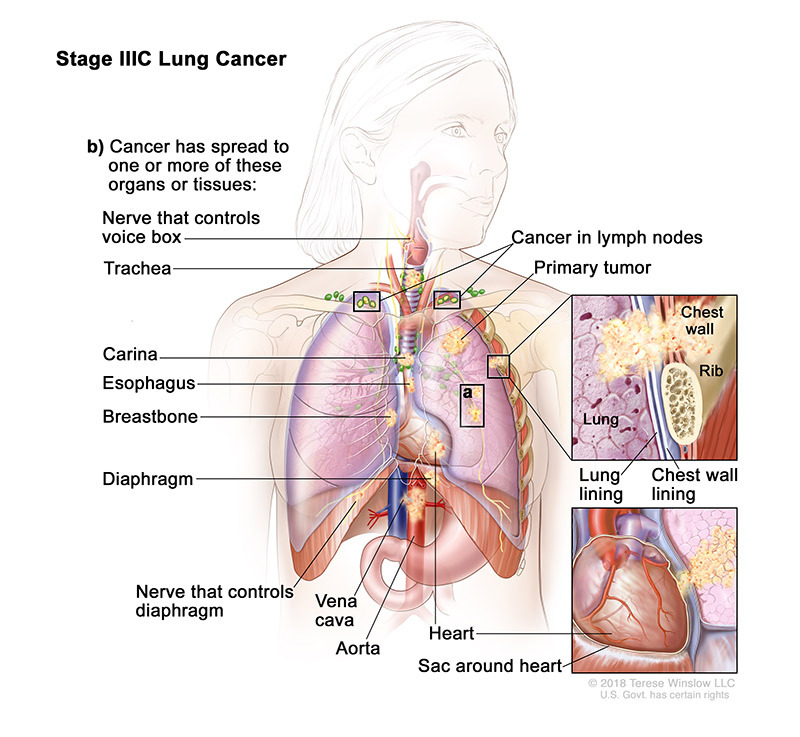
Stage IV Lung Cancer
Stage IV NSCLC is categorized as either stage IVA or IVB. Cancer can be any size and may or may not have grown into nearby structures or spread to the lymph nodes.
- Stage IVA: The tumor has one or more of the following features:
- There are one or more tumors in the lung that does not have the primary tumor.
- The cancer has spread to the other lung.
- Cancer cells are found in the fluid around the lung or heart.
- Cancer has spread to one place in an organ or tissue not near the heart.
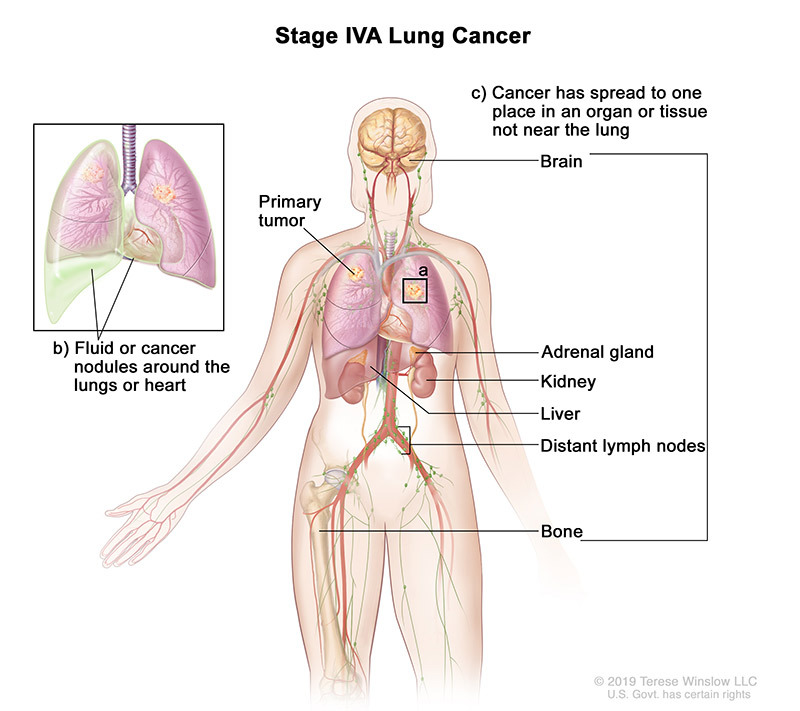
- Stage IVB: The cancer has spread to multiple places in one or more organs, not near the lungs. It has grown as more than one tumor outside the chest, such as to distant lymph nodes and/or to other organs such as the liver, bones, or brain.
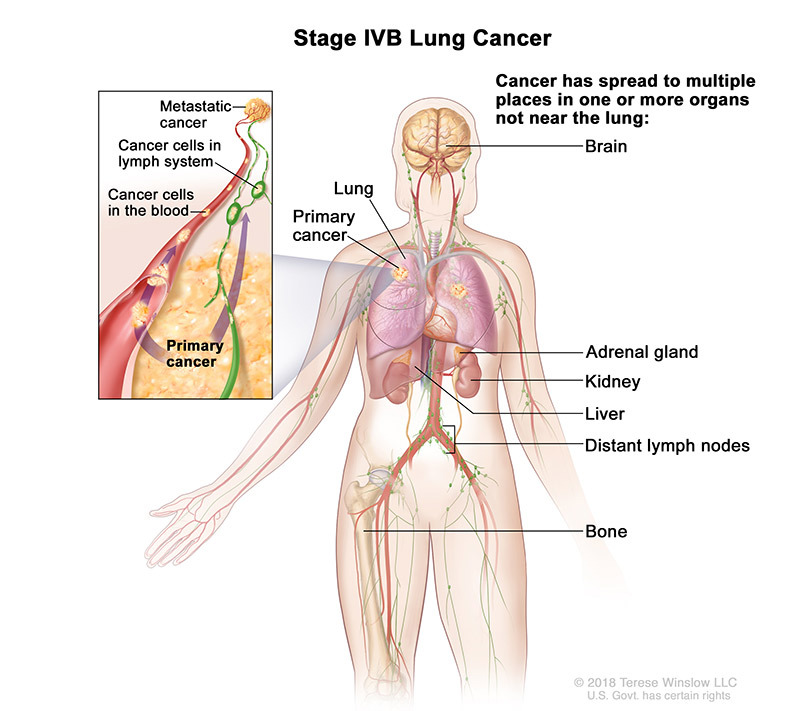
Recurrent Lung Cancer
Even with the advanced cancer treatment options available today, lung cancer can return after remission. The chance of lung cancer returning after treatment depends on the lung cancer type and the stage it was in when during the initial treatment. Lung cancer recurrence is categorized based on where the cancer returns. The three types are local recurrence, regional recurrence, and distant recurrence.
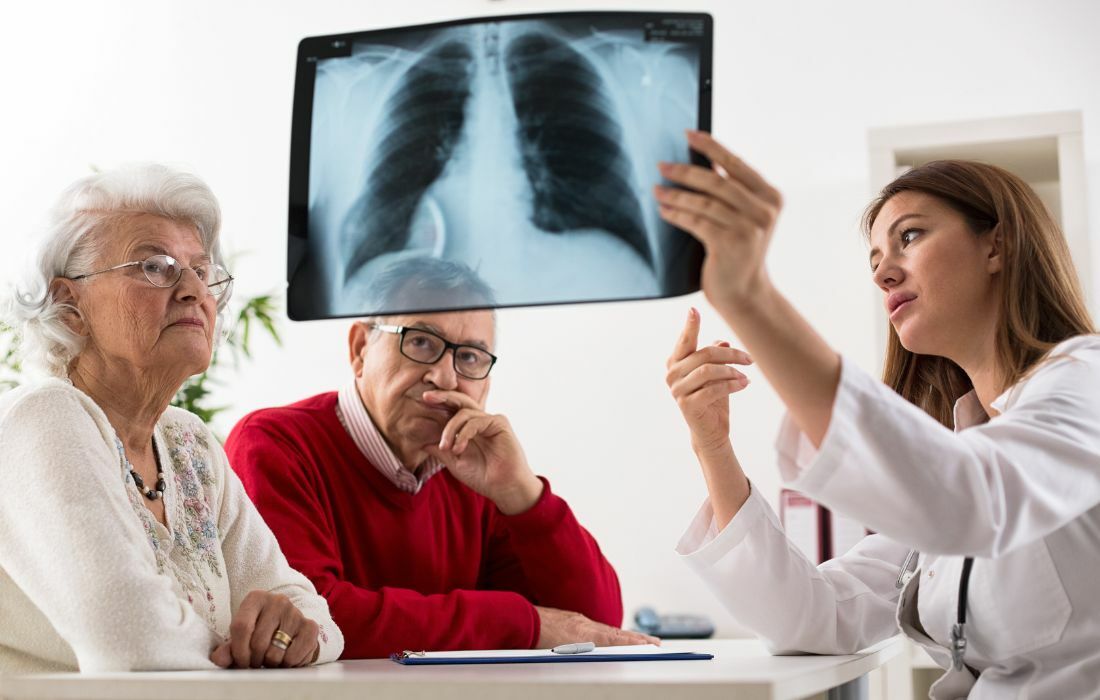
Lung Cancer Care and Treatment in Brevard County
If you or a loved one have been newly diagnosed with lung cancer, oncologists at the Cancer Care Centers of Brevard specialize in lung cancer and are ready to guide you through this journey. We provide patients throughout Brevard County with the latest lung cancer treatment options based on your unique type of cancer. Find an oncologist to discuss treatment plans for lung cancer.